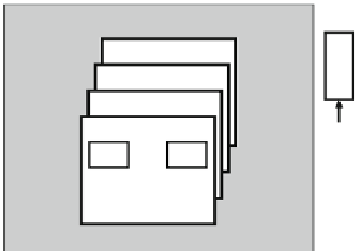Hardware Reference
In-Depth Information
SH-X3 Cluster
SH-X3 Core3
SH-X3 Core2
SH-X3 Core1
SH-X3 Core0
CPU
SNC: Snoop Controller (Cntl.)
DAA: Duplicated Address Array
CRU:Cache RAM Control Unit
I$/D$: Instruction (Inst.)/Data Cache
IL/DL: Inst./Data Local Memory
URAM: User RAM
DBG: Debug Module
GCPG/LCPG: Global/Local CPG
INTC: Interrupt Cntl.
SHPB,HPB: Peripheral Bus Bridge
CSM: Centralized Shared Memory
DMAC: Direct Memory Access Cntl.
PCIe: PCIexpress Interface (i/f)
SCIF: Serial Communication i/f
GPIO: General Purpose IO
TMU: Timer Unit
CRU
FPU
IL
I$
D$
DL
URAM
DBG
On-chip system bus (SuperHyway)
HPB
Fig. 4.4
Block diagram of RP-1
4.2.2
SH-X3 Cluster
The four SH-X3 cores constitute a cluster sharing an SNC and a DBG to support
symmetric-multiprocessor (SMP) and multicore-debug features. The SNC has a
duplicated address array (DAA) of data caches of all the four cores and is connected
to the cores by a dedicated snoop bus separated from the SuperHyway to avoid both
deadlock and interference by some cache coherency protocol operations. The DAA
minimizes the number of data cache accesses of the cores for the snoop operations,
resulting in the minimum coherency maintenance overhead. Each core can operate
at different CPU clock (ICLK) frequencies and can stop individually to minimize
the power (see Sect.
4.2.3
). The coherency protocol was optimized to avoid the
interference that results from a slow core to a fast core (see Sect.
4.2.4
).
4.2.3
Dynamic Power Management
Each core can operate at different CPU clock (ICLK) frequencies and can stop indi-
vidually, while the other processors are running with a short switching time in order
to achieve both the maximum processing performance and the minimum operating
power for various applications. A data cache coherency is maintained during opera-
tions at different frequencies, including frequencies lower than the on-chip system
bus clock (SCLK). The following four schemes make it possible to change each
ICLK frequency individually while maintaining data cache coherency:
1. Each core has its own clock divider for an individual clock frequency change.
2. A handshake protocol is executed before the frequency change to avoid conflicts
in bus access, while keeping the other cores running.
































Search WWH ::

Custom Search